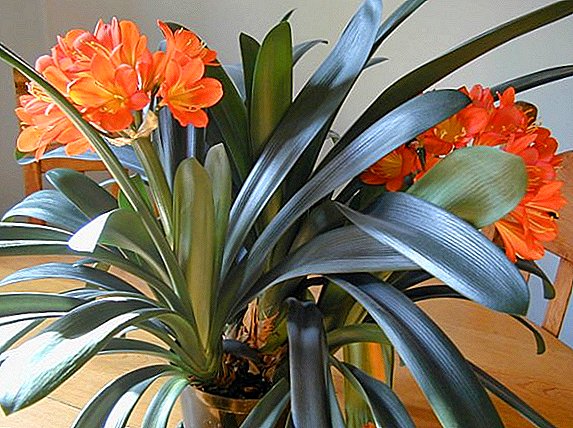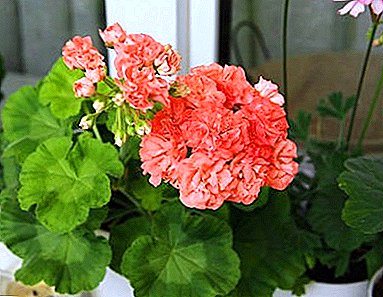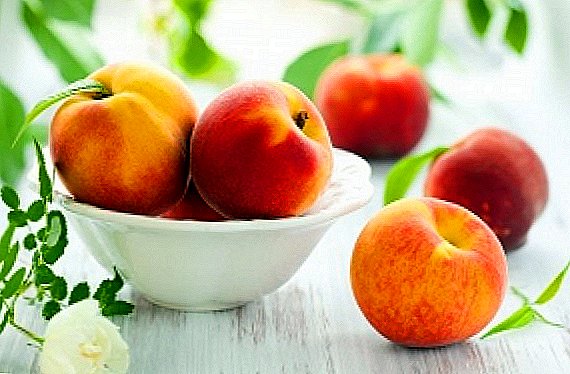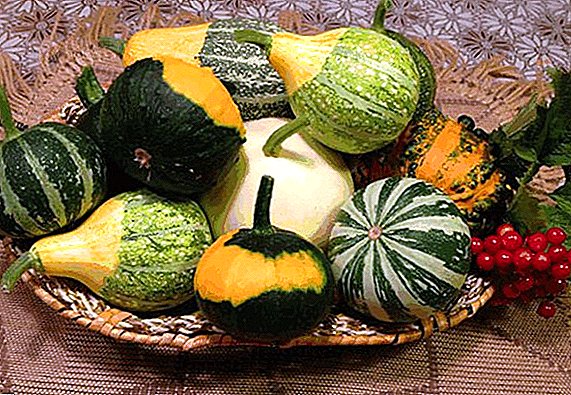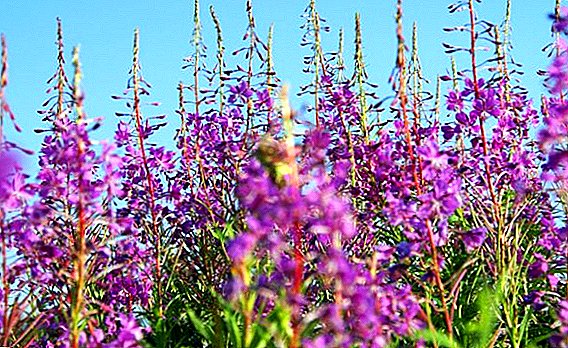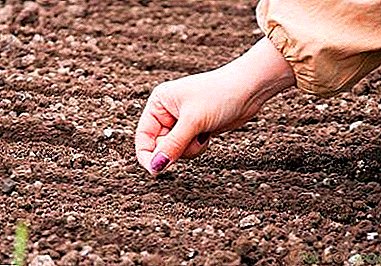
Growing carrots is a fairly time-consuming exercise, since it implies careful adherence to agricultural practices. To obtain a good harvest, it is important to prepare the soil in advance, process and harden the seeds, choose the most suitable time for planting, do not be mistaken with the choice of variety, provide painstaking care for young shoots.
Errors at each stage can lead to a decrease in yield or deterioration of its quality. In the article you can read the recommendations for planting and growing carrots, as well as after what culture it is better to plant.
Advantages and disadvantages
 One of the main advantages of planting carrots in the spring is the possibility of sowing early varieties.that will be ready to eat in the middle of summer. In addition, only spring can plant late varieties.
One of the main advantages of planting carrots in the spring is the possibility of sowing early varieties.that will be ready to eat in the middle of summer. In addition, only spring can plant late varieties.
The disadvantages include the need to clearly follow the recommendations for optimal weather conditions for landing. If suddenly, due to the vagaries of the weather, unexpected frosts or a sharp cooling will come, the seeds may either slow down their growth or die at all. However, this can be avoided by using a film or covering material.
Sorta
For different regions there is a set of varieties, which is most preferable for this climatic zone with its special weather conditions. Some varieties are universal and suitable for growing in several regions at once:
| Maturing maturity | Middle band | Siberia | Ural |
| Early |
|
|
|
| Mid-season |
|
|
|
| Late |
|
|
|
When to plant?
In the middle lane, the earliest time to start planting carrots falls on April 20-30th. During this period, planting early-maturing varieties, which by mid-July can be consumed fresh, as well as making winter harvesting.
Can I plant carrots at the end of May? If you plant carrots in late May or early June, preference should be given to mid-season and late varieties - the resulting crop will go to long-term storage for consumption in winter.
In other regions, the first spring crops of carrots begin a little later - in the Urals, this should be done not earlier than the first days of May, and in Siberia - from May 10.
Step-by-step instructions: how to plant?
Inventory preparation
 For planting carrots use as homemade devices, and industrial units. The simplest devices are a special syringe, a seeder and a roller. The principle of their operation is the same - the seeds are pushed inwards, which, with the help of pressing, push the seed into a prefabricated groove. Such devices are suitable for small acreage.
For planting carrots use as homemade devices, and industrial units. The simplest devices are a special syringe, a seeder and a roller. The principle of their operation is the same - the seeds are pushed inwards, which, with the help of pressing, push the seed into a prefabricated groove. Such devices are suitable for small acreage.
Also at the time for the proper fit can not do without a rake or hoe to make the grooves. If we are talking about a larger area of planting, use complex models and devices that are designed for such an application.
Seed
- Before planting, we first need to weed out unsuitable seeds. To do this, pour them with warm water and leave for 10 hours. Good seeds will settle to the bottom, and bad ones will surface.
- Then, for better germination of seeds, in preparation, it is necessary to wash off the seeds of essential oils. To this end, the seeds are folded in a gauze bag and placed in hot water (45-50 degrees) for 20-30 minutes. The bag is shaken periodically so that the seeds are better washed. After that, the seeds are again washed in cold water and laid out on a clean, dry cloth to dry.
- Two weeks before planting, it is necessary to soak the seeds for two hours with water, then put it on a damp cloth and cover it with another piece of damp cloth on top. Soaked seeds are left at room temperature, periodically stirred, and moisture is added if the fabric is dried.
- As soon as the seeds are swollen and begin to germinate, they are placed for 10 days in a refrigerator for hardening. After that, the seeds are ready for planting.
Garden bed
2-3 weeks before planting in the soil, you can make mineral fertilizers. Immediately before planting, the future garden bed should be watered, loosened, made sure that there are no stones and lumps left in the ground, sprinkled with ashes.
Microclimate for growing
Carrots can be planted when the soil has warmed to 8–9 ° C, and daytime temperatures are around 14–16 ° C. Such temperature norms in the middle band are typical for the second half of April. Carrots love a well-lit place, so the plot should choose one where the sun constantly shines.
Predecessors
After which it is better to plant a carrot? Best of all carrot feels on beds on which grew:
- tomatoes;
- cucumbers;
- bow;
- potatoes;
- cabbage;
- garlic.
Proper seeding
 How to sow the seeds and how deep is planted?
How to sow the seeds and how deep is planted?
- It is better to prepare the soil for the preparation of the soil before sowing in the fall - the area is dug up, after introducing humus and wood ash. It is not recommended to use fresh manure; nitrogen fertilizers should be applied with caution, since excess nitrogen during the summer period will affect the decrease in the keeping quality of the crop.
- Grooves for planting seeds make a depth of not more than 3 cm at a distance of 20-30 cm from each other.
- The furrows are shed with water, they press down a little on the ground to thicken the soil, and plant seeds.
- Then the grooves are leveled with earth and covered with a film so that the first shoots appear faster.
- As soon as the first shoots ascend, the film is removed.
Seedling method
The seedling method of planting carrots is practiced by gardeners, but it is less popular compared to planting seeds. This is due to the fact that transplanting seedlings is more labor-intensive, carrots from seedlings suffer more from lateral shoots and more often grow less in weight and size, worse stored.
Nevertheless, this method also has advantages:
- terms of receiving the first harvest are significantly reduced;
- no need to thin out the beds;
- carrot fly overcomes less such planting;
- easier to fight weeds.
AT Depending on the type of carrot, the first shoots appear on the 7-20th day after landing. 2-3 weeks they need to give grow, and then can be transplanted into open ground.
Thus, start sowing seeds in seedlings:
- early varieties possible 3-4 weeks before landing in the ground;
- mid-season varieties - 4-5 weeks;
- late - for 5-6 weeks.
Soil for seedlings can be purchased or prepared independently in the fall (for example, a mixture of peat, sand and ash in a ratio of 10: 5: 0.1). The thickness of the soil in the tank for planting should be at least 15 cm.
- Seeds are planted to a depth of 2 cm at a distance of 3 cm from each other.
- Since carrots love moisture, the first time you need abundant watering. As soon as the first shoots appeared, the frequency of watering is reduced to two times a week, and they begin to carry out seedlings on the balcony or garden to a sunny place for hardening and airing.
- After regrowth of the third leaflet, the seedlings can be fed with the prepared mixture or you can prepare the fertilizer yourself (dilute 12 g of ammonium nitrate, 15 g of superphosphate and 15 g of potassium sulfate in 5 l of water).
- As soon as the fourth leaf appeared, the seedlings are ready to be transplanted into the ground. Pre-seedlings need to be watered well to replant each seedling along with a clod of earth.
Seedless method
When planting seeds there are several ways. The easiest and fastest way is to mark the grooves and put seeds in them as evenly as possible. With this method of landing inevitably thinning.
Therefore, some gardeners practice a little more time-consuming ways of planting, which further avoid thinning:
 The first method involves the use of homemade paste based on potato starch (3 tbsp. L. / 1 liter of water). 4-6 g of seeds and 4-5 g of fertilizers are added to the resulting liquid (Agricola, Sudarushka or other fertilizers for vegetables will do). The resulting solution is poured into a container with a dispenser and slowly poured into the beds, which are then covered with soil and compacted.
The first method involves the use of homemade paste based on potato starch (3 tbsp. L. / 1 liter of water). 4-6 g of seeds and 4-5 g of fertilizers are added to the resulting liquid (Agricola, Sudarushka or other fertilizers for vegetables will do). The resulting solution is poured into a container with a dispenser and slowly poured into the beds, which are then covered with soil and compacted.- In the second method, one part of the seed is mixed with ten parts of coarse sand and one part of fertilizer. The resulting mixture is distributed in the grooves.
- Some gardeners use purchased or home-made ribbons, on which seeds are glued at a distance of 4-5 cm from each other.
- You can also use the so-called marker (it can be a long stick with teeth cut out or attached on the rib) - pressing them on the soil, there will be holes in the garden where the seeds are placed.
Plant Care
Primary, immediately after sown
- Before the appearance of the first shoots of carrots, abundant watering is required — twice a week, four liters per meter of bed.
- As soon as the first shoots appeared (basically it happens 2 weeks after planting), the first thinning should be done (if the seeds were planted in the most usual way). Do not delay and wait for the first edible roots to appear - by this time thinning will be done late, the quality of the crop will have decreased. The distance between the sprouts is about 4 cm.
- In parallel, they begin to fight weeds.
- After thinning it is necessary to water the beds copiously.
Subsequent
- Some time after the first thinning, it is the turn of the second thinning. This time it is worth leaving a distance of at least 8 cm. If a variety with large fruits is planted, the distance can be increased to 15 cm.
- Watering is gradually reduced to once a week. Approximate consumption will be one bucket per square meter beds.
- Weeding remains the same component of caring plant care.
- Also, once a week it is recommended to loosen the soil between the rows and around the sprouts - this will allow to saturate the soil with oxygen, as well as increase its ability to pass moisture. Thanks to this, carrots will grow faster and it will be easier to harvest in the future.
- Approximately a month after the appearance of the first shoots, you can add dressing - 1 tbsp. l Nitrofoski or nitroammofoski stir in 10 liters of water, and watering sprouts at the rate of 5 liters per 1 square. After three weeks you can repeat top dressing - the solution should be prepared according to the same recipe, but increase the flow rate to 8 liters per 1 square meter. m
- We must not forget about the fight against the main pest of carrots - the carrot fly, which begins to lay eggs in the ground in spring. As one of the methods of struggle used planting next to carrots onions, the smell of which deters the fly.
After each thinning, remove the topped tops immediately, otherwise left tops will attract a fly. If, however, contamination could not be avoided, you can prepare a mixture of ash and tobacco, and sprinkle this powder between the rows.
I do not like the carrot fly and the smell of red pepper. You can use the purchase of insecticides - for this fit Actellik or Intavir.
Problems and solutions
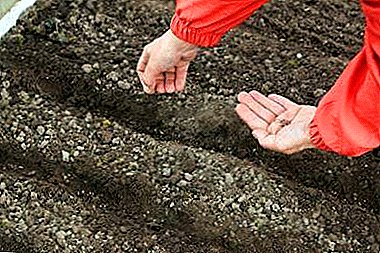 If you do not guess with the most favorable days for planting carrots (unexpected frosts, cold snap), there is a threat to the entire future harvest. However, the use of film or covering material can help solve this problem.
If you do not guess with the most favorable days for planting carrots (unexpected frosts, cold snap), there is a threat to the entire future harvest. However, the use of film or covering material can help solve this problem.- Also, during the spring planting, all gardeners are faced with the active growth of weeds, which at the initial stage can clog the young shoots of carrots.
- To make the carrot easier to identify, you can put radishes, lettuce or spinach in each row along with the carrots. They sprout faster and make it easier to determine where the crop grows, and where the weed.
- And, finally, a headache for gardeners can be an invasion of carrot flies, in the fight against which industrial insecticides are suitable, pollination with tobacco with ashes, and planting in neighboring beds of onions.
Despite the fact that the autumn planting of carrots is popular among gardeners, still most of them choose the spring planting in order to be able to grow early varieties for consumption in the middle of summer, and later ones for storage in winter.
As with any other culture planting and growing carrots has its own characteristics, subtleties, difficulties. Knowing them, you can achieve excellent results on the cultivation of this root on your site.


 The first method involves the use of homemade paste based on potato starch (3 tbsp. L. / 1 liter of water). 4-6 g of seeds and 4-5 g of fertilizers are added to the resulting liquid (Agricola, Sudarushka or other fertilizers for vegetables will do). The resulting solution is poured into a container with a dispenser and slowly poured into the beds, which are then covered with soil and compacted.
The first method involves the use of homemade paste based on potato starch (3 tbsp. L. / 1 liter of water). 4-6 g of seeds and 4-5 g of fertilizers are added to the resulting liquid (Agricola, Sudarushka or other fertilizers for vegetables will do). The resulting solution is poured into a container with a dispenser and slowly poured into the beds, which are then covered with soil and compacted. If you do not guess with the most favorable days for planting carrots (unexpected frosts, cold snap), there is a threat to the entire future harvest. However, the use of film or covering material can help solve this problem.
If you do not guess with the most favorable days for planting carrots (unexpected frosts, cold snap), there is a threat to the entire future harvest. However, the use of film or covering material can help solve this problem.